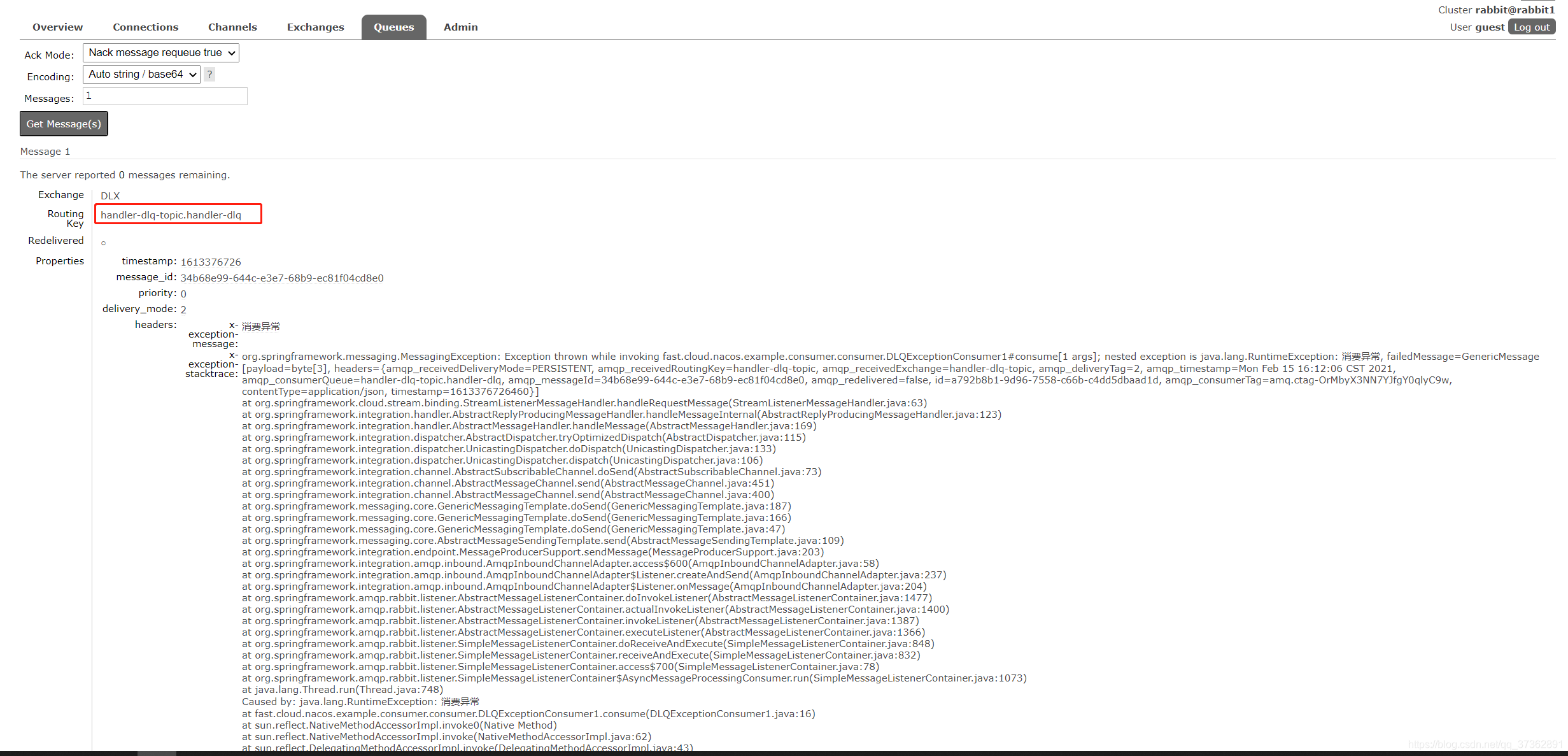
前言
之前写过一篇,spring kafka 死信队列,这个文章是写的spring kafka的,该篇记录下基于spring cloud stream实现死信队列,方便以后用到的时候翻阅,有不对的地方或者需要改进的地方,还请各位提出。
RabbitMQ实现
环境搭建
还是老规矩使用docker-compose启动,下面先给出脚本,这是搭建了一个集群的方式。
version: "2"
services:
rabbit1:
image: rabbitmq:3.8.3-management
hostname: rabbit1
ports:
- 5672:5672
- 15672:15672
environment:
- RABBITMQ_DEFAULT_USER=guest
- RABBITMQ_DEFAULT_PASS=guest
rabbit2:
image: rabbitmq:3.8.3-management
hostname: rabbit2
ports:
- 5673:5672
- 15673:15672
environment:
- CLUSTERED=true
- CLUSTER_WITH=rabbit1
- RAM_NODE=true
links:
- rabbit1
rabbit3:
image: rabbitmq:3.8.3-management
hostname: rabbit3
ports:
- 5674:5672
environment:
- CLUSTERED=true
- CLUSTER_WITH=rabbit1
links:
- rabbit1
- rabbit2
docker-compose up -d
可以看到如下日志

我们通过主机ip + 15672访问,账号、用户名均为guest

代码演示
代码已经上传到github上面
- 演示
consumer的代码首先引入pom文件,如下所示:
<dependency>
<groupId>org.springframework.cloud</groupId>
<artifactId>spring-cloud-starter-stream-rabbit</artifactId>
</dependency>
<dependency>
<groupId>org.springframework.boot</groupId>
<artifactId>spring-boot-starter-web</artifactId>
</dependency>
- 创建一个
chanel的接口
public interface DLQExceptionChannel {
String OUTPUT = "handler-dlq-topic-output";
String INPUT = "handler-dlq-topic-input";
@Output(OUTPUT)
MessageChannel output();
@Input(INPUT)
SubscribableChannel input();
}
- 定义一个消费者的类
@Slf4j
@Component
@EnableBinding(DLQExceptionChannel.class)
public class DLQExceptionConsumer1 {
@StreamListener(DLQExceptionChannel.INPUT)
public void consume(String message) {
log.info("接收消息:{}", message);
throw new RuntimeException("消费异常");
}
}
- 配置
application.yml文件
server:
port: 9999
spring:
rabbitmq:
host: 192.168.56.124
port: 5672
cloud:
stream:
default:
contentType: application/json
bindings:
handler-dlq-topic-input:
destination: handler-dlq-topic
group: handler-dlq
consumer:
max-attempts: 1 # 设置最大重试次数
rabbit:
bindings:
example-topic-input:
consumer:
delayed-exchange: true
handler-dlq-topic-input: #私信队列配置
consumer:
auto-bind-dlq: true
dlq-ttl: 50000
republish-to-dlq: true
- 演示
provider的代码,首先是pom文件
<dependency>
<groupId>org.springframework.cloud</groupId>
<artifactId>spring-cloud-starter-stream-rabbit</artifactId>
</dependency>
<dependency>
<groupId>org.springframework.boot</groupId>
<artifactId>spring-boot-starter-web</artifactId>
</dependency>
- 定义一个
channel,这个和上面的保持一样
public interface DLQExceptionChannel {
String OUTPUT = "handler-dlq-topic-output";
String INPUT = "handler-dlq-topic-input";
@Output(OUTPUT)
MessageChannel output();
@Input(INPUT)
SubscribableChannel input();
}
- 定义一个发送者类
@Slf4j
@EnableBinding(DLQExceptionChannel.class)
public class DLQExceptionMessageProducer1 {
@Resource
private DLQExceptionChannel channel;
public void produce(String message) {
log.info("发送消息:{}", message);
channel.output().send(MessageBuilder.withPayload(message).build());
}
}
- 定义一个
web访问的端点
/**
* 异常发送到DLQ私信队列
*
* @param message
* @return
*/
@GetMapping("/dlqException")
public String dlqException(@RequestParam String message) {
log.info("Send: " + message);
dlqExceptionMessageProducer1.produce(message);
return "ok";
}
- 配置
application.yml文件
server:
port: 8888
spring:
rabbitmq:
host: 192.168.56.124
port: 5672
cloud:
stream:
default:
contentType: application/json
bindings:
handler-dlq-topic-output:
destination: handler-dlq-topic
rabbit:
bindings:
example-topic-output:
producer:
delayed-exchange: true
测试代码
- 分别启动两个项目,通过访问
http://localhost:8888/dlqException?message=aaa,可以观察到消费者的控制台打印出异常日志

- 这个时候观察rabbtimq的管理页面,查看是否有死信消息发送到死信队列,可以观察到死信队列已经有消息了,证明测试成功了。

Kafka实现
环境搭建
搭建单机版kafka,docker-compose.yml文件如下:
version: '2'
services:
zookeeper:
image: wurstmeister/zookeeper ## 镜像
ports:
- "2181:2181" ## 对外暴露的端口号
kafka:
image: wurstmeister/kafka ## 镜像
volumes:
- /etc/localtime:/etc/localtime ## 挂载位置(kafka镜像和宿主机器之间时间保持一直)
ports:
- "9092:9092"
environment:
KAFKA_ADVERTISED_HOST_NAME: 192.168.56.124 ## 修改:宿主机IP
KAFKA_ZOOKEEPER_CONNECT: 192.168.56.124:2181 ## 卡夫卡运行是基于zookeeper的
kafka-manager:
image: sheepkiller/kafka-manager ## 镜像:开源的web管理kafka集群的界面
environment:
ZK_HOSTS: 192.168.56.124 ## 修改:宿主机IP
ports:
- "9000:9000"
代码演示
代码已经上传到github上面
- 首先是
consumer代码,给出pom依赖
<dependency>
<groupId>org.springframework.cloud</groupId>
<artifactId>spring-cloud-stream</artifactId>
</dependency>
<dependency>
<groupId>org.springframework.cloud</groupId>
<artifactId>spring-cloud-starter-stream-kafka</artifactId>
</dependency>
<dependency>
<groupId>org.springframework.boot</groupId>
<artifactId>spring-boot-starter-web</artifactId>
</dependency>
- 定义一个
consumer类去消费,这里没有自定义channel,直接使用默认的。
@Slf4j
@EnableBinding(SpringStreamChannel.class)
public class SpringStreamMessageConsumer {
@StreamListener(SpringStreamChannel.CONSUMER)
public void consume(String message) {
log.info("接收消息:{}", message);
}
}
- 配置
application.yml文件
spring:
cloud:
stream:
kafka:
binder:
brokers: 192.168.56.124:9092
bindings:
input:
consumer:
# When set to true, it enables DLQ behavior for the consumer. By default, messages that result in errors are forwarded to a topic named error.<destination>.<group>.
# messages sent to the DLQ topic are enhanced with the following headers: x-original-topic, x-exception-message, and x-exception-stacktrace as byte[].
# By default, a failed record is sent to the same partition number in the DLQ topic as the original record.
enableDlq: true
dlqName: custom-message-dlq
keySerde: org.apache.kafka.common.serialization.Serdes$StringSerde
valueSerde: com.boot.kafa.consumer.dlq.model.CustomMessageSerde
autoCommitOnError: true
autoCommitOffset: true
bindings:
input:
group: kafka-streams-dlq-sample # must have group name
destination: custom-message-topic
useNativeDecoding: true
consumer:
maxAttempts: 3 # 当消息消费失败时,尝试消费该消息的最大次数(消息消费失败后,发布者会重新投递)。默认3
backOffInitialInterval: 1000 # 消息消费失败后重试消费消息的初始化间隔时间。默认1s,即第一次重试消费会在1s后进行
backOffMultiplier: 2 # 相邻两次重试之间的间隔时间的倍数。默认2,即第二次是第一次间隔时间的2倍,第三次是第二次的2倍
backOffMaxInterval: 10000 # 下一次尝试重试的最大时间间隔,默认为10000ms,即10s。
server:
port: 9999
- 生产者者的代码,首先给出
pom
<dependency>
<groupId>org.springframework.cloud</groupId>
<artifactId>spring-cloud-starter-stream-kafka</artifactId>
</dependency>
<dependency>
<groupId>org.springframework.boot</groupId>
<artifactId>spring-boot-starter-web</artifactId>
</dependency>
- 自定义一个
channel
public interface OutputChannel {
@Output("output2")
MessageChannel output2();
}
- 定义一个web的访问端点
@GetMapping("/produce")
public void produce() {
dlqMessageProducer.produce(CustomMessage.builder()
.data("test")
.count(1).build());
}
- 配置
application.yml
spring:
cloud:
stream:
kafka:
binder:
brokers: 192.168.56.124:9092
bindings:
output2:
destination: custom-message-topic
contentType: application/json
server:
port: 8888
测试代码
-
启动两个项目,访问
http://localhost:8888/produce,看到日志报错

-
看下kafka是否生成死信消息
docker exec -it kafka_容器id /bin/bash
cd /opt/kafka/bin
./kafka-console-consumer.sh --bootstrap-server 192.168.56.124:9092 --topic custom-message-dlq

可以看到死信队列已经有消息,说明测试成功。